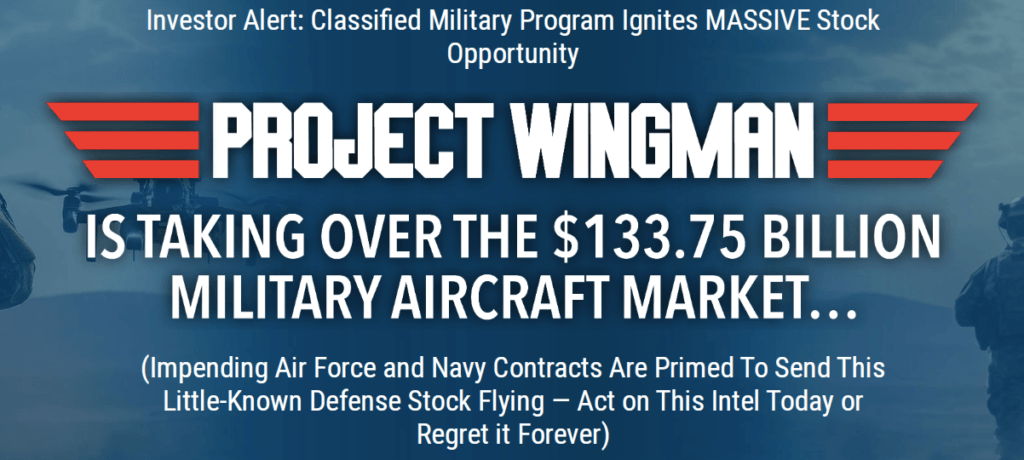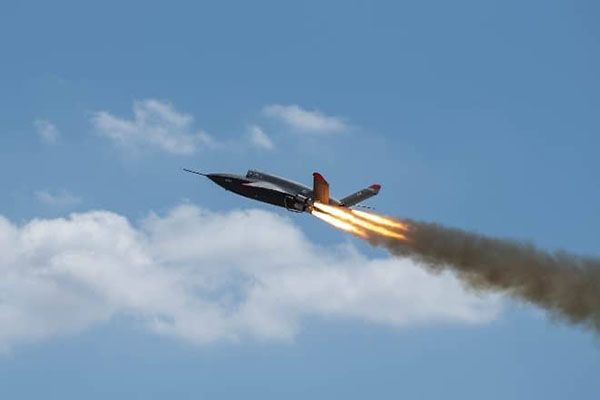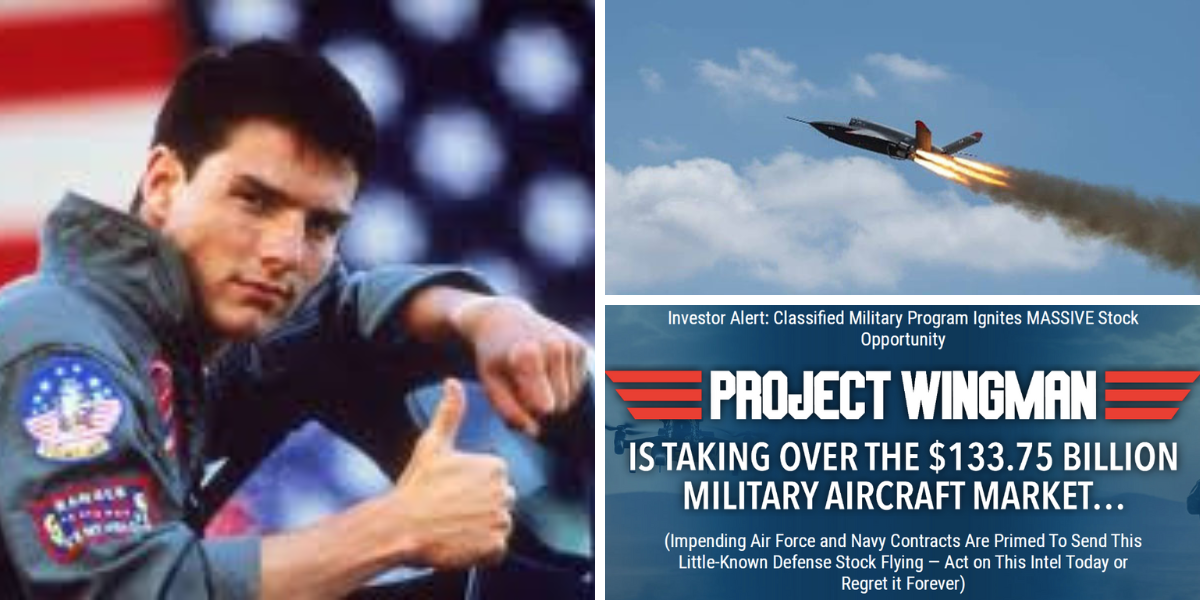Conflicts are raging all around the world, and Jason Simpkins is opportunistically teasing a “Project Wingman” defense stock.
Not only does it make airspace more secure and save the lives of countless military personnel, but it could soon become the largest military contractor in the world.
We reveal what it is in this teaser review for free.
The Teaser
In 2020, a covert arm of the U.S. military ran an exercise that would change the aviation industry forever.

Jason Simpkins is the Investment Director of Angel Publishing, covering everything from mining companies to energy companies, and defense contractors.
He's also an investment newsletter industry veteran, getting his start with Agora Publishing in 2007.
Back to the teaser, the covert arm of the U.S. military Jason referenced at the beginning is the Defense Advanced Research Projects Agency (DARPA).
What DARPA set out to create was the “perfect pilot.”
One that doesn't require years of training, has superhuman reflexes, and most importantly, never loses.
The end result was “Project Wingman,” which Jason says is changing the trajectory of U.S. military technology and could translate to a “50x return for early shareholders.”
So, what is it and what sets it apart?
Collaborative Combat Aircraft
Unlike your typical drone that flies by remote control, there's an entirely new kind of combat plane.
It's called a Collaborative Combat Aircraft or CCA and they are AI-controlled support fighters that look like this:

Think of them as robot wingmen whose job it is to support human jetfighters with a variety of combat functions, from probing enemy defenses with sensors and radar equipment to acting as shields, and even relaying critical information.
The use cases for these AI-controlled fighters are practically endless and better still, at only 5% of the cost of a human-controlled F-35, with no human lives onboard to consider, CCAs can be deployed with limited risk.
It's no wonder the U.S. Air Force has already committed to purchasing 1,000 CCAs, which could be just the tip of the iceberg.
One little-known defense company that already supplies key technology to military aircraft is behind the CCA AI pilot technology everyone is clamoring for.
The Pitch
Jason has compiled a detailed report explaining everything we need to know about this company and its AI flight technology called “Project Wingman: Tiny AI Defense Stock With 20x–50x Potential.”

This report is exclusive to members of the weekly investment advisory Secret Stock Files which costs $1,999 to join.
A membership includes a 90-day money-back guarantee, new monthly stock recommendations, unrestricted access to an entire archive of recommendations, and a model portfolio tracking dozens of stock picks.
The Answer to an Urgent Crisis
As I write this, the percentage of Americans eligible to serve in the U.S. military has never been lower.
Despite the U.S. Air Force and the Navy already loosening restrictions to make up for this shortage, the pool of eligible recruits is still shrinking.
There are a few reasons for this concerning state of affairs.
First among these is a plain old lack of interest or sense of duty, depending on which way you look at it.
According to Defense Department surveys, only 9% of service-age Americans say they want to serve in the armed forces.
Like much of the country, the military has become divided – for those on the left, it's an overly conservative institution, while for those on the right, new military policies are making it too left-leaning.
However, an even bigger challenge beyond political ideology is the startling fact that only 23% of service-age Americans now meet the required fitness, mental health, and drug-use standards.
Young Americans are increasingly overweight, using weed at record rates, and reporting unprecedented mental health challenges.
But this set of problems is not unique to the US.
In an internal document, the UK’s Royal Air Force admitted that it “urgently needs to solve a shortage of trained pilots.”
Germany's armed forces are also facing major problems in attracting new recruits.
All this at a time when the risk of a large-scale conflict hasn’t been so high in decades.
Based on all of these troubling trends, the timing of AI-piloted CCAs can hardly be better and Jason's tiny defense stock is perfectly positioned to profit from the answer to an urgent crisis.
Revealing Jason Simpkins' “Project Wingman” AI Defense Stock
Clues are generic and spread out throughout the teaser, here is what we have to work with:
- This company has been working directly with the United States Air Force for several years to produce CCAs as part of the “Project Wingman” initiative.
- Over the last few months, the Navy awarded it a $47 million contract for ballistic missile systems, the Air Force gave it a $54 million contract to develop a low-cost expendable engine, and the Army recently signed a $95 million deal to buy its target drones.
- Its stock is currently valued today at roughly $2 billion.
After scouring some defense news websites, I can confirm that Jason's pick is Kratos Defense & Security Solutions Inc. (Nasdaq: KTOS).
- Kratos is one of three contractors hired by the U.S. Air Force to build unmanned drones under the Skyborg AI combat drone program, which Jason calls “Project Wingman.”
- It has been awarded a $47 million contract for submarine ballistic missiles, $54 million to develop a low cost, limited-life engine, and $95 million to supply unmanned aerial target systems to the US Army.
- KTOS stock is currently valued at $3.7 billion after a 25% run-up so far this year.
Real 20x–50x Potential?
Kratos would need to become a $74-$185 billion company to meet Jason's lofty target.
Based on what we know about the business today, how likely is this?
At first glance, Kratos' 17% year-over-year organic revenue growth is good, but nothing special.
However, its 62% organic revenue growth in Unmanned Systems is.
This is the part that was highlighted in Jason's teaser and which contributed nearly one-third of Kratos' $300 million in Q2 2024 revenue.
Importantly, the business is also growing profitably, with positive free cash flow being reported over the last few quarters and a record bid pipeline of $12 billion.
From a fundamental standpoint, Kratos' underlying economics in the form of its ROE could be a lot better, but due to its rapid growth, it is investing heavily back into manufacturing capacity, infrastructure, and R&D to address growing U.S. National Security needs, so we'll give it a pass.
The only real downside at this time is Kratos' valuation.
At 48x forward price/earnings, we are paying dearly for the future growth of the business. But if your time horizon is long enough (10-20 years), the 20-bagger potential is there.
Quick Recap & Conclusion
- Defense-stock specialist Jason Simpkins is opportunistically teasing a “Project Wingman” stock, which is not only helping make airspace more secure but is also saving the lives of countless military personnel.
- We learned that this little-known defense contractor supplies key technology to a growing military segment called Collaborative Combat Aircraft (CCA), which is next-gen unmanned aircraft.
- Jason has compiled a detailed report explaining everything we need to know about this company and its AI flight technology called “Project Wingman: Tiny AI Defense Stock With 20x–50x Potential.” This report is exclusive to members of the weekly investment advisory Secret Stock Files which costs $1,999 to join.
- Fortunately, if you read this review until the end, you didn't have to pay a penny because we revealed Jason's “Project Wingman” defense stock for free as Kratos Defense & Security Solutions Inc. (Nasdaq: KTOS).
- At 48x forward price/earnings, Kratos is expensive, but it is a fast-growing defense contractor whose largest segment is unmanned aircraft systems, a huge growth niche itself, which gives it 20-bagger potential over the long term.
Is there a defense technology stock with greater potential? Drop it in the comments below.
